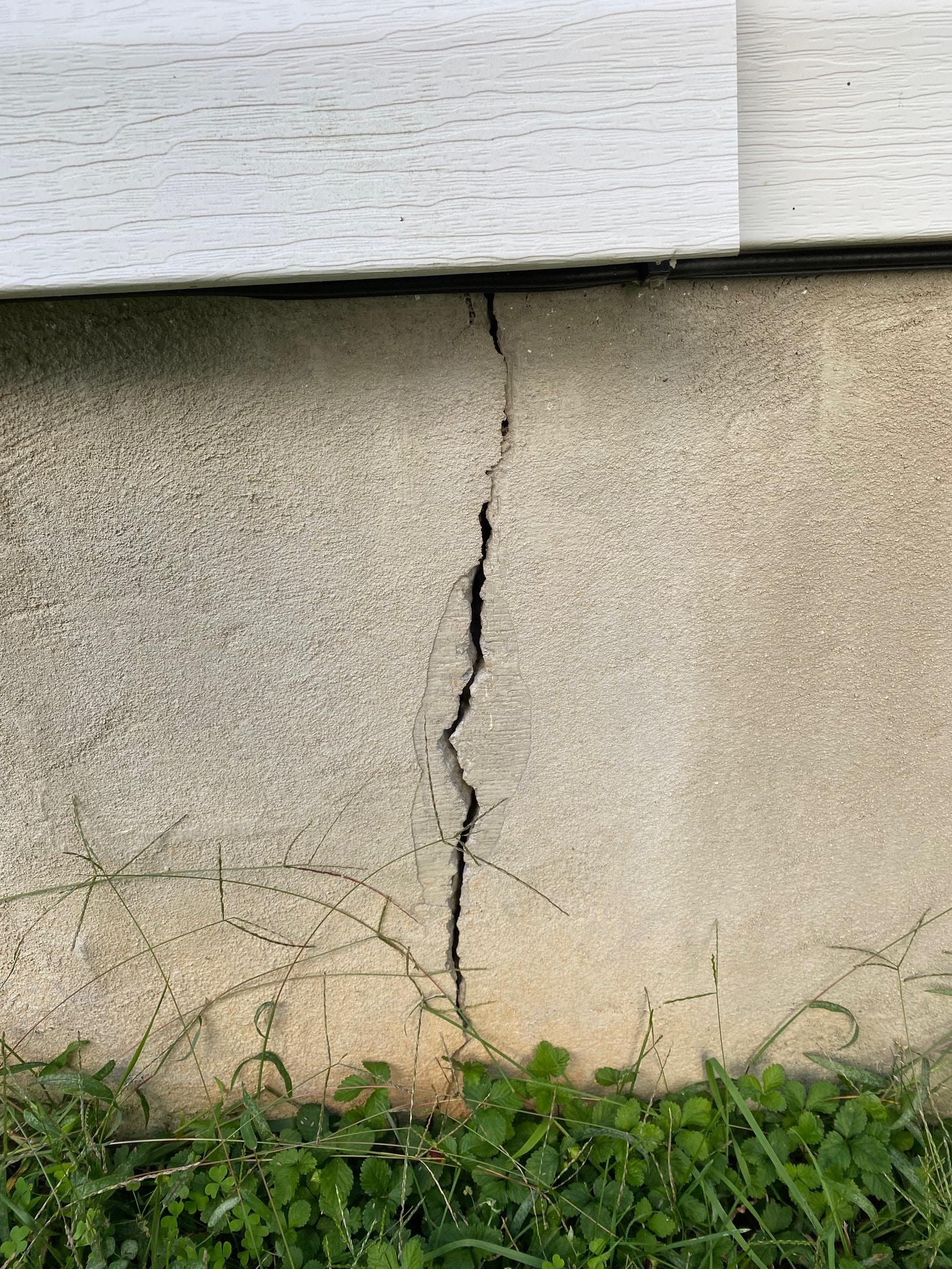
You’ve probably heard that a bit of foundation settling is normal, even expected, in new homes. But how do you distinguish between harmless settling and a potential structural nightmare? You’ve seen the warning signs: cracks in the walls, doors not lining up quite right. Yet, not every crack spells disaster. The key lies in understanding the soil beneath your feet and the environmental factors at play. Let’s shed some light on this topic, to help you protect your property value and get a good night’s sleep. There’s more to this than meets the eye, isn’t there?
Key Takeaways
- Foundation settling is a normal phenomenon influenced by factors like soil composition, drainage, and load distribution.
- Common signs include cracks in walls, misaligned doors or windows, and sloping floors, but not all signs necessarily indicate severe damage.
- Regular home inspections are vital for differentiating between normal settling and significant foundation issues.
- Myths surrounding foundation settling often lead to misconceptions, highlighting the importance of professional assessments and advice.
- Preventive measures, timely professional help, and the foundation’s condition significantly affect a property’s value.
Understanding Foundation Settling
You may not realize it, but foundation settling is a common occurrence in many homes. It’s all about the soil composition beneath your building. Different types of soils react differently to pressure and moisture, which can lead to drainage issues.
Groundwater fluctuations, too, can cause the soil to expand or shrink, resulting in shifting. Construction practices play a significant role as well. If the building materials used were substandard, or if local regulations weren’t strictly followed, your foundation might be more prone to settling.
Environmental factors, such as tree roots pushing against the foundation or seismic activity in your area, can also contribute to this issue. Seasonal changes are another vital factor. The freeze-thaw cycle in colder regions, for example, can cause soil to expand and contract, leading to movement in your foundation.
It’s essential to understand these aspects, so you can take appropriate measures to protect your home’s structural integrity.
Common Signs of Settling
You’ve learned what foundation settling is; now let’s identify its common signs.
Look for cracks in exterior walls, misalignment of doors and windows, or uneven and sloping floors.
Recognizing these signs early on can help you address the issue before it escalates.
Cracks in Exterior Walls
Without a doubt, cracks in exterior walls are a telltale sign of foundation settling. When you spot these, it’s time to start investigating. You should pay close attention to the crack patterns, as they can provide clues about the severity of the settling.
Hairline cracks, for example, are often superficial and may not indicate a serious problem. However, larger, horizontal cracks could suggest significant shifting in the foundation, requiring immediate attention.
But don’t panic just yet. Many times, these cracks are the result of natural settling and don’t necessarily mean your home is on the brink of collapse. It’s important to monitor them over time. If they continue to grow or multiply, that’s when you should consider repair options.
There’s a range of solutions out there, from simple cosmetic fixes to more extensive structural repairs. The best approach depends on the extent and cause of the damage.
It’s always wise to consult with a professional before making any decisions. They can assess the situation, provide a diagnosis, and recommend the most suitable and cost-effective repair options for your specific case.
Doors and Windows Misalignment
Noticing difficulties with doors and windows is another common sign of foundation settling. You might find doors sticking, not closing properly, or windows that are hard to open. This could be due to a shift in the home’s foundation which has caused misalignment in your door frames and window seals.
Let’s dive deeper into the specifics. The table below shows the common signs, the primary cause, and the potential solution.
| Sign | Cause | Solution |
|---|---|---|
| Sticking Doors | Misaligned door frames | Adjustment or replacement |
| Windows Hard to Open | Shifted window seals | Window repair or replacement |
| Visible Gaps | Foundation movement | Foundation repair |
If you’re spotting these signs, it’s important to not brush them off. Sure, they might seem like minor problems, but they’re indicators of bigger issues beneath the surface. You’re likely dealing with foundation settling that needs attention.
Uneven or Sloping Floors
Walking across your home, have you felt a distinct incline or decline underfoot? If so, it’s a sign of uneven or sloping floors, a common symptom of foundation settling. You may have shrugged it off, but this isn’t an issue you should ignore.
Uneven floors impair your home’s structural integrity, posing safety risks. As your foundation settles, it can create gaps causing your floors to slope.
What’s more, it can lead to more serious structural damage over time if left unchecked.
Floor leveling is a solution to this problem. It’s a process where professionals elevate your home’s foundation to its original position.
It’s a specialized task that requires expert knowledge and tools. Don’t attempt to fix it yourself, as you might cause further damage.
Factors Affecting Foundation Settling
When it comes to your home’s foundation, a number of factors can influence its settling. First, consider the soil composition. Different types of soil contract and expand at varying rates which can cause settling. Sandy soils drain well, while clay soils retain water, leading to expansion and contraction.
Drainage issues also play a significant role. If water isn’t properly directed away from your foundation, it can cause the soil to swell, resulting in foundation movement. Conversely, if moisture levels are too low, soil can contract, creating gaps where your foundation can settle.
Tree roots can grow under your foundation, drawing moisture from the soil, causing it to shrink. Temperature fluctuations, too, impact the soil’s volume, leading to foundation settling.
The way your home was built, or construction practices, including how the soil was prepared before the foundation was poured, can also affect settling. Landscaping choices, like planting large trees close to the home, can exacerbate issues.
Lastly, load distribution within your home can lead to uneven settling. If heavy furniture or appliances are concentrated in one area, it could cause that section of your foundation to settle more than others.
Differentiating Between Settling and Serious Damage
While your home’s foundation is designed to accommodate some amount of settling, it’s important to distinguish between normal settling and serious damage that could compromise your home’s structural integrity.
Settling causes range from natural soil consolidation to changes in the moisture content of the soil. You’ll see minor cracks, sticking doors, or uneven floors as signs of usual settling.
But don’t panic, these signs don’t necessarily mean you’re facing a foundation disaster. Regular inspections and damage assessment play a crucial role in determining the severity of the situation.
If you notice growing cracks or walls pulling away, it’s time to call in the professionals. These could be warning signs of serious damage caused by factors like poor soil conditions, excessive moisture, or inadequate foundation design.
Taking the time to understand the difference can save you unnecessary worry and expense.
So, remember, not all settling is bad. But, always keep a vigilant eye on your home’s foundation. Make sure to differentiate between what’s normal and what could potentially lead to serious damage.
If you’re in doubt, always seek professional advice.
Myths Surrounding Foundation Settling
You’ve likely heard a lot about foundation settling, but how much of it’s accurate?
Let’s bust some common myths and misconceptions that often cloud the truth.
Common Foundation Settling Myths
Despite what you may have heard, not all foundation settling is a sign of impending disaster. It’s time to play myth busters and explore the foundation facts.
- All Settling is Bad: This is one of the most common myths. Some degree of settling is normal and expected, especially in new homes.
It becomes a problem when settlement is uneven or excessive.
- Cracks Always Mean Trouble: Not all cracks indicate a serious problem. Hairline cracks can occur naturally as concrete cures and shrinks.
However, large or widening cracks should be evaluated by a professional.
- DIY Fixes are Enough: While some minor issues can be addressed on your own, professional evaluation and repair should always be considered if the problem persists.
- Insurance Covers Foundation Damage: Most homeowner’s insurance policies don’t cover foundation damage unless it’s caused by a specific event like a flood.
You’re not alone in falling for these myths.
But now, armed with the truth, you’re better prepared to evaluate your home’s foundation situation and know when it’s time to call in the experts.
Don’t let these myths cloud your judgment.
Debunking Settling Misconceptions
Let’s explore four more misconceptions surrounding foundation settling.
Myth one: “All settling is bad.” Not necessarily. It’s normal for a new house to settle a bit. However, excessive settling can indicate a problem. Knowing the foundation truths helps discern between normal and problematic settling.
Myth two: “Foundation cracks always mean settling.” This is one of the settling myths that needs dispelling. Cracks can occur for several reasons, not just settling. Environmental factors, like extreme weather or soil conditions, can also cause them.
Myth three: “Older homes don’t settle.” On the contrary, any home, regardless of age, can settle. It’s more about the conditions around the home than its age.
Lastly, myth four: “If my doors and windows stick, it’s due to settling.” While it’s possible, sticking doors and windows can also be caused by humidity or improper installation.
Understanding Real Settling Issues
After dispelling some common foundation settling myths, it’s time to address the real issues with settling.
- Soil Composition and Drainage Issues: The soil your home sits on plays a significant role in settling. Certain soil types can shrink or swell with moisture levels and seasonal changes, causing your foundation to move.
Drainage issues can exacerbate this problem, leading to water pooling and further soil disruption.
- Construction Materials and Foundation Types: The materials used in your foundation and the type of foundation can also impact settling. Some materials may not withstand certain environmental conditions, leading to deterioration over time.
- Geographic Location and Seismic Activity: Where you live matters. Some regions have more seismic activity, which can cause your foundation to shift.
Additionally, tree roots in your area can interfere with your foundation, causing it to crack and settle.
- Building Codes: If your home wasn’t built to code, it’s more likely to have foundation issues.
These codes are designed to guarantee your home can withstand the pressures of its environment, including the soil composition, moisture levels, and seismic activity.
Understanding these issues can help you prevent and address foundation settling in your home.
Foundation Settling Prevention Methods
To protect your home from foundation settling, proactive steps are vital. Two key approaches to prevention are implementing drainage solutions and promoting soil stabilization.
Your home’s surroundings can greatly contribute to foundation problems. As a result, good drainage solutions are essential. They help to prevent water buildup that can cause soil expansion, leading to foundation settling. You can achieve this by installing gutters and downspouts, ensuring they direct water away from your home.
Soil stabilization is another important prevention method. This process involves the use of various techniques to enhance the physical properties of the soil, increasing its stability and reducing the risk of settling.
Here’s a handy table summarizing these prevention methods:
| Prevention Method | Purpose | Benefits |
|---|---|---|
| Drainage Solutions | Prevent water buildup | Reduces soil expansion |
| Soil Stabilization | Enhance soil properties | Increases soil stability |
| Proper Landscaping | Ensures water flows away from home | Prevents water pooling near foundation |
| Routine Inspection | Early detection of issues | Prevents serious damage |
| Foundation Maintenance | Keeps foundation in ideal condition | Extends foundation lifespan |
When to Seek Professional Help
While you can take preventive measures, it’s important to recognize when professional help is needed for foundation settling issues.
The truth is, the settling causes are often too complex for a simple DIY fix. You shouldn’t let fear of costs keep you from reaching out to experts when necessary.
Knowing the signs that require professional intervention is vital. Here are four indicators you need to watch out for:
- Large cracks appearing in your walls or floors
- Doors and windows that are hard to open or close
- Uneven or sloping floors
- Separation between walls, ceilings, and the foundation
Following maintenance tips can help minimize these issues, but sometimes, it’s not enough.
If you’re seeing any of the signs listed, it’s time to call in the professionals. They can provide a thorough assessment and propose effective solutions to your foundation settling problems.
Impact on Property Value
You might be wondering how foundation settling affects your property’s value. Well, it’s a significant factor that you can’t ignore. When it comes to a property appraisal, the condition of the foundation is crucial. Appraisers are trained to spot signs of foundation settling and it can negatively impact the value of your home.
Consider this: you’re selling your house. Potential buyers will likely hire inspectors who’ll catch any foundation issues. Serious problems could lead to buyers backing out or requesting a price reduction.
On the other hand, if you’re buying, you wouldn’t want to invest in a property with a shaky foundation, would you? That’s a risk you’d want to avoid, especially considering the cost of foundation repairs.
Market trends also play a role. In a seller’s market, buyers may overlook minor issues. But in a buyer’s market, they’re more likely to be choosy. A house with foundation problems might sit longer on the market, reducing its value.
Frequently Asked Questions
Is Foundation Settling Covered by Homeowners Insurance?
It’s not always clear-cut.
Typically, homeowners insurance doesn’t cover foundation settling as it’s considered regular home maintenance. However, if the settling is caused by a covered peril like a flood or earthquake, you might be able to make insurance claims.
You should check your policy’s coverage limits and exclusions. Always consult with your insurance provider for accurate information.
Can Foundation Settling Cause Health Issues?
Yes, foundation settling can cause health issues.
When your home’s structural integrity is compromised, it can lead to water seepage and mold growth. You’re exposed to health risks like respiratory problems and allergies.
Cracks from settling can also create tripping hazards. It’s essential to address any signs of foundation settling swiftly to protect both your home’s stability and your personal well-being.
Are Certain Types of Foundations More Prone to Settling?
Yes, certain foundation types are more prone to settling.
It’s not only about the type, but also the soil composition underneath. Slab foundations, for instance, can settle if they’re built on expansive clay or improperly compacted fill soils.
Pier and beam foundations can also shift if the soil isn’t stable.
How Long Does It Take for a Foundation to Settle?
It’s hard to pinpoint exactly how long it’ll take for a foundation to settle, as it depends on many factors.
However, you’ll typically notice settling signs within the first few years.
If you’re seeing cracks or other issues, don’t wait.
The quicker you address foundation repairs, the better.
Can Weather Changes Accelerate Foundation Settling?
Yes, weather changes can indeed accelerate foundation settling.
When weather patterns fluctuate, it considerably affects soil moisture levels. In periods of heavy rainfall, soil expands, putting pressure on your foundation. Conversely, during dry spells, soil contracts, causing it to pull away.
This constant push and pull can expedite the settling process, potentially leading to foundation damage. It’s essential to monitor these conditions to maintain your home’s structural integrity.
Conclusion
So, settling isn’t always a bad sign, but it’s not something to ignore either. Your home’s foundation is essential to its overall health, so don’t dismiss cracks or misaligned doors. Remember, environmental factors and soil composition matter too. Regular inspections can help spot issues early, and professional help can determine if it’s normal settling or serious damage. Protecting your foundation safeguards your property value, so stay proactive and informed.

Seal-tite Basement Waterproofing Co. is a full service basement environment contractor. We carry an A+ Better Business Bureau rating. We repaired over 40,000 homes and structures in Virginia, West Virginia, Tennessee, and North Carolina. We are fully insured and licensed. We have worked in all types of locations, including residential and commercial locations, government agencies, colleges, hospitals, churches, and condo associations.
Seal-tite® offers a lifetime transferable warranty. We carry a Class A Contractor’s License and we are fully insured. Our satisfied customers range from government agencies to businesses, hospitals, colleges, churches, and thousands of homeowners. Your home is probably the single largest investment you will make in your lifetime. Don’t wait, call Seal-tite® to help make your home dry, safe and livable.

